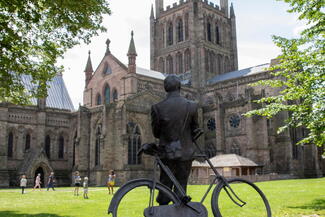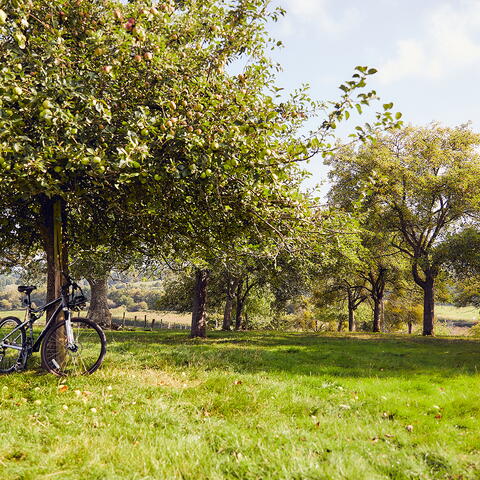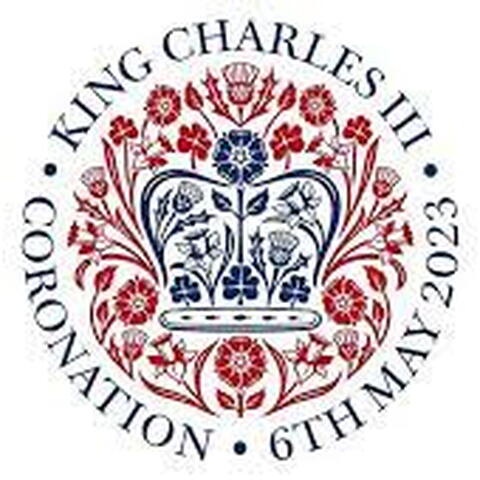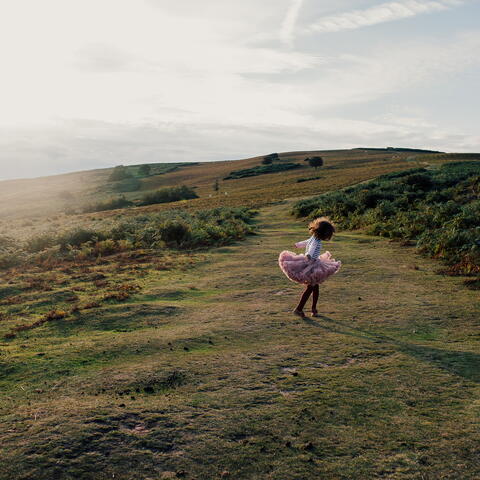A cyclist’s guide to the Watkins Way
Celebrating the discovery of ley lines by local man Alfred Watkins

Cycling the 106-mile Watkins Way over five days lets you enjoy the glorious views, plentiful historical sites and the challenge of the undulating landscape, without exhausting yourself. The middling pace of pedal power – fast enough to get around but slow enough to see the sights – is perfect for Herefordshire. Or take the challenge up a gear and tackle the route over 3 days. Being one of the most rural parts of the UK, it’s sensible to pack sustenance for the road and plenty of spare inner tubes just in case.

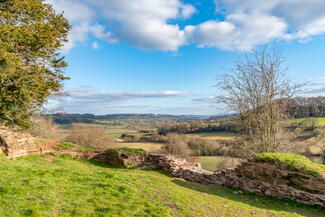
1. Woolhope Church, HR1 4QR
The start of a few days of beautiful riding is appropriately peaceful and picturesque, with the route beginning at Woolhope Church. If you’re cycling from Hereford, expect a significant climb to Woolhope itself – but you earn it back in the other direction. It’s worth getting in the mindset of expecting a climb around every corner, too. An early highlight is crossing the River Wye, where you can pause to appreciate the vista. This first section sets the tone for much of the route: quiet roads and near-constant ups and downs.
2. Dinedor Hill, HR2 6PD - 7.95miles
Dinedor Hill is one of a few points on the trip where you come briefly off the GPS route, which you can download and display on your phone here. Follow the route as normal, but continue beyond it just a bit further to the top of the hill and the very rewarding views. As with some of the other stops and sights on the route, it involves a very slight detour off the road, but one well worth it. If you want to investigate the Iron Age hill fort that sits at the top, dismount and explore on foot.
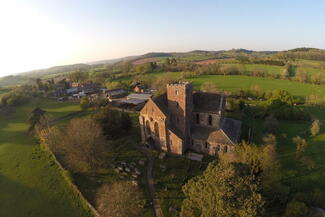
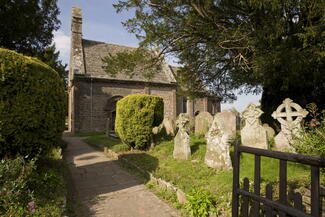
3. Kilpeck Church & Castle, HR2 9DN - 9.63 miles
After carefully making your way back down the steep Dinedor Hill, head south for several miles, passing by another Iron Age hill fort, Aconbury Camp, before taking a hard right towards Kilpeck. Here you’ll find the Kilpeck Inn, home to a very friendly floppy-eared pub dog called Ollie, and a great spot to recharge your batteries with pub grub in the garden. Mere metres away is the elaborately carved Kilpeck Church and the remains of Kilpeck Castle - just lock your bike in the pub garden and head over on foot. The Kilpeck Inn also has four luxury rooms if you’re looking for a place to stay the night.
4. Dore Abbey, HR2 0AA - 5.08 miles
If Kilpeck whet your appetite for history and impressively grand old churches, you haven’t got long to wait before one of the highlights of the trip, Dore Abbey, which is about five miles away via Wormbridge, passing by Gilbert’s Hill Wood. A very short detour off the road after crossing the River Dore brings you to a churchyard, with the abbey itself set towards the back, imposing and proud. There are headstones hundreds of years old in the churchyard; look out for Thomas Jackson’s, inscribed with an apt poem on the passage of time in such a historical setting: Pass a few swiftly fleeting years, And all that now in bodies live, Shall quit like me, the vale of tears, Their righteous sentence to receive.
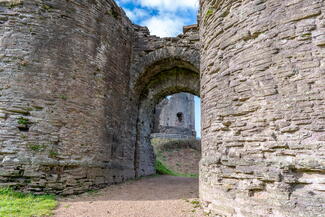
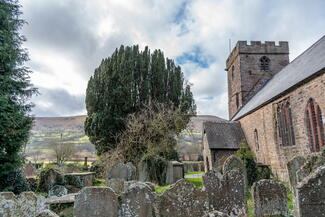
5. Clodock Church, HR2 0PD - 5.13 miles
A series of very sharp climbs and descents – amounting to nearly 700ft of elevation gain in about five miles of riding – take you to Longtown, to which you’ll return after taking a short detour to get to St Clydawg Church in Clodock, which dates back to the 6th century. The name hints at a strong Welsh influence; this section of the route is the closest to the Welsh border.
6. Longtown Castle, HR2 0LE - 1.17 miles
After miles of nearly-deserted countryside, Longtown feels almost bustling in comparison. There’s a village store and Post Office en route, as well as a campsite and the Crown Inn pub and B&B, making it an ideal stopping point for the first night. Directly on the route but set back from the road, the fascinating and impressive keep of Longtown Castle offers views of the Black Mountains and, thanks to Historic England, helpful signs to guide you round the ruins and give you some historical context. A grassy area with a picnic bench opposite the entrance to the castle grounds offers a useful spot to park your bike and refuel.
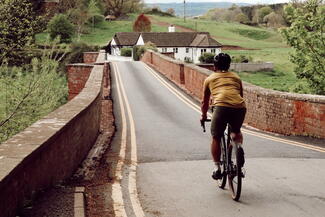
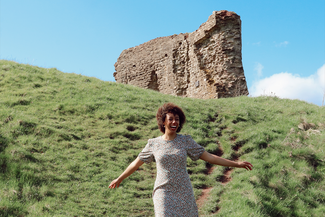
7. Michaelchurch Escley Church, HR2 0JS - 5.1 miles
Most of the ride to Michaelchurch Escley involves a straight blast north, riding parallel to the River Monnow, hidden in the valley below, for several miles. The ride heads steadily uphill until you emerge from trees and tall hedgerows to traverse a ridge with views of the valley below you to your right. Much of the riding here is along very quiet singletrack roads, with the rolling fields only occasionally broken up by farmhouses. An ensuing right turn will take you through a sharp climb then rapid descent into Michaelchurch Escley, home to St Michael's Church and the exceptionally pretty Bridge Inn pub, which sits practically on top of Escley Brook. Here you’ll find gin manufactured by the pubs’ owners and the perfect spot to rest after some hilly riding. The Bridge Inn's owners also operate a cosy and immaculately-kept B&B as well as glamping, if you’re looking for accommodation.
8. Snodhill Castle, HR3 6BG - 6.89 miles
One could be forgiven for being lulled into a false sense of security by the section of riding to Snodhill Castle which features a series of pleasant, sweeping downhills that tick the miles along in a pleasant rush of greenery. But once at Snodhill Castle, it’s probably a good idea to prepare yourself for what’s in store next - the toughest climb on the route - as well as taking a look around the remains of the 12-sided keep. Enjoy the brilliant views from the castle, one of the largest and oldest examples of a Norman castle in Britain. Keep a keen eye out for the entrance as you approach – it’s ever-so-slightly hidden, though there are plenty of signs and explanatory guides once you’re there.

9. Moccas Hill Wood, HR3 6AX - 2.19 miles & Arthur’s Stone, HR3 6AX - 0.72 miles
Here comes the hard bit: a seriously hefty slog up Dorstone Hill, which in places is as steep as 25%, meaning that for each four metres you’re moving forward, you’re gaining one metre elevation. In places it will feel nearly vertical. This is the most significant test of your fitness on the route, and most likely of your bicycle’s gears, too. It’s a triumphant feeling once you emerge from the climb, with resplendent views to your left, and Moccas Hill Wood to your right. The road soon descends nearly as steeply as it climbed, but beware: don’t go too far. The way to Moccas Hill Wood (on the right of Pentre Lane) and Arthur’s Stone Road (on the left) arrives pretty rapidly thanks to the steep downhill, and you don’t want to miss the turning, just to have to turn around and climb the hill again. The short road to Arthur’s Stone also involves a sharp climb, though not as significant as Dorstone Hill. The atmospheric Neolithic burial chamber is the most ancient landmark on the route and pre-dates Stonehenge by a millennium. It’s also a good spot to sit, eat some well-earned sandwiches, and enjoy the view.
10. Bredwardine Church & Castle Mound, HR3 6BT - 2.11 miles
After that epic climb, the next two mile stretch provides blissful relief, with some seriously fast descending out towards the Red Lion hotel, where you take a right turn to head into Bredwardine. St Andrew’s in Bredwardine is another fine example of the Herefordshire’s country churches, and with a well-kept churchyard, it’s easy to hop off the bike and have a look around. It’s also the burial place of Francis Kilvert, a nineteenth-century clergyman who lived in the area and is now famous for the posthumously-published Kilvert’s Diary. The banks of the River Wye are also nearby, where you can walk past the medieval fish ponds, frequented by swans.
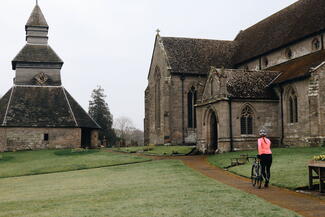
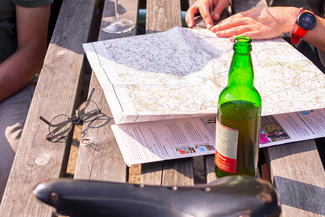
11. Eardisley Church & Castle Mound, HR3 6NL - 4.31 miles
Back on the bike, the route takes you back over the River Wye for the first time since the start of the journey. A brief passage of quiet country roads typical to this route is soon replaced by the only section of main road riding, along the A438. The Swan Inn, home to a pub, rooms and a campsite, all with an ethical slant, is situated on the A438, shortly after the turn from Brobury, and another good overnight option. The Orgasmic Cider Company is also just a short way off the main road if you fancy picking up a tipple. The village of Eardisley is known for its beautiful Black and White buildings as well as its church, with a notable Norman font.
12. Pembridge Church & Old Market House, HR6 9HH - 11.12 miles
One of the longest single stretches on the route, it’s worth being psychologically prepared for the ride from Eardisley to Kington, where you take a right at the roundabout on to the A44. The deceptively long and tough stretch up to Kington may catch you by surprise – there are no lung-busting sharp turns common to the earlier stretches of the route, but the consistent climb will take it out of you nonetheless. Follow the A44 along a relatively flat section, noting the increasing number of black and white buildings in the quintessential local style, until you enter the wonderful village of Pembridge. There are a number of eateries, shops and pubs here that make it an extremely pleasant spot to while away a few hours after some taxing miles.
Townsend Touring and Camping Park is just on the edge of Pembridge, while there are also some self-catering options available in Grade II listed accommodation in the characteristic Black and White style. If you don’t plan on staying in Pembridge, it’s still advised you unclip from your pedals and have a look around the church and local pubs including The New Inn.
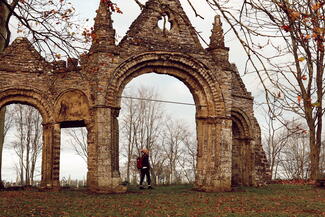
13. Shobdon Church & Arches, HR6 9LZ - 4.67 miles
Head next for Shobdon, to the north, and home to a remarkable Grade I church, notable for its rococo style and dazzling white interior which sits at the end of a long tree-lined drive. Not far from the main church, on an adjacent hill, are the Shobdon Arches. They formed part of the original church and were placed here as a folly in 1756 when the church was rebuilt. The surrounding grounds are very peaceful and a prime spot for a packed lunch.
14. Wigmore Castle & Church, HR6 9UB - 5.97 miles
A swift ride from Shobdon downhill towards Mortimer’s Cross brings you to a relatively busy crossroads, home to The Grange, a pub with rooms in a thirteenth-century building. Turn left at the crossroads on to the A4110 towards Wigmore, passing by the Watering Hole Cafe and more black and white houses in Aymestrey, as well as The Riverside – beside the River Lugg – which presents a thoroughly tempting option for thirsty cyclists. A slight incline through lush green scenery brings you to Wigmore, one of the larger villages on the route. The Oak in Wigmore is a perfect spot to stay the night and is mere minutes away from Wigmore Castle. This large and overgrown ruin dates as far back as 1070 and was once home to the mighty Mortimer family. It’s not accessible by bike, so park up in town and enjoy the views on foot. There are several other accommodation locations in Wigmore, including the Castle Inn and self-catering options.
15. Richards Castle Church & Castle, SY8 4ET - 6.58 miles
After breakfast, head east towards Richard’s Castle, which sits on the border of Herefordshire and Shropshire, and home to St Bartholomew’s Church and 11th century Castle as well as a very pretty churchyard. This being Herefordshire, these can be found at the top of a steep hill following a left-turn off Woodhouse Lane. There is a detached bell tower, dating from around 1400, which was likely part of the castle's defences, according to local historians. There are excellent views here and a very peaceful atmosphere. Take it carefully on the steep, narrow road back down towards the main Richard’s Castle village. There are more examples of the black and white houses in Richard’s Castle, and the Castle Inn pub for a quick drink.
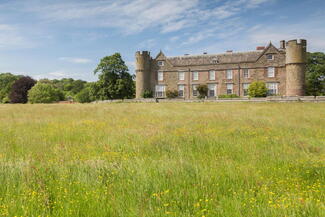
15. National Trust Croft Castle & Croft Ambrey Hillfort , HR6 9PW - 5.77 miles
The route then starts its final leg southwards towards Leominster and Hereford, but first taking a very notable side-quest to Croft Castle, a major National Trust attraction. Cycle along a long and pretty single-lane path towards the grounds. You can park your bike at designated locking points near the cafe, which serves good coffee, cakes and more. As well as the Castle itself, there are designated walking routes through the grounds and Fishpool Valley, home to a series of ponds and a variety of wildlife, as well Croft Ambrey, a large Iron Age hillfort. Cycling out of Croft Castle is particularly enjoyable, as it whisks you downhill through the grounds, with the imposing castle looming behind you. With about 20 miles remaining on the route, you might fancy resting up one last night, though you’ll be relieved to hear that the bulk of the major hills are behind you. The Mortimer Trail B&B, The Grange at Mortimer’s Cross and The Riverside at Aymestrey are your nearest accommodation options.
16. Blackwardine, HR6 0NE - 10.37 miles and Hereford via Sutton St Nicholas - 11.8 miles
The final blast southwards towards Hereford calls for a stop-off at Blackwardine, where a standing stone has been erected in commemoration of its significance - this was the spot where Alfred Watkins had his revelation about the existence of key lines, the inspiration for this route. Make your way towards Sutton St Nicholas, where you’ll see some of the last of the famous black and white houses on the trip. Take it carefully at the downhill section before Saffrons Cross, about four miles before Sutton St Nicholas – there’s a sharp descent before a junction for a main road, so you’ll need to be hard on the brakes. After Sutton St Nicholas, cross the River Lugg once again before heading into Hereford — up one final hill — where there are abundant excellent eateries and places to sleep, such as Green Dragon Hotel and Castle House Hotel. Spend some time admiring the Cathedral, relax with a drink by the river, and take in the atmosphere on the main high street, content in the knowledge that you’ve just experienced the county in all its glory.
